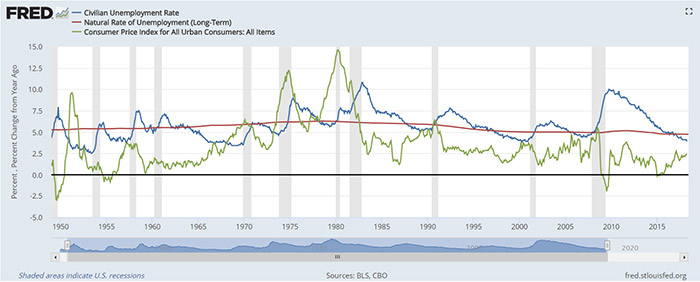Members of the Federal Reserve have tough jobs. They try to manage how fast the economy grows. So, when the economy grows too fast, in their opinion, they try to slow it down without causing a recession.
Usually, they manage to slow the economy. But they also end up causing a recession.
Elected representatives don’t like recessions because constituents often blame them for slow economic growth and high unemployment. That sometimes results in election losses for incumbents.
To prevent recessions, and election losses, Congress gave the Fed a dual mandate. In 1977, Congress told the Fed to “promote effectively the goals of maximum employment, stable prices and moderate long-term interest rates.”
Like many Congressional mandates, this one is good in theory but impractical to implement.
The Fed’s Dual Mandate
In practice, the Fed uses interest rates to maximize employment and minimize inflation. These are the two goals of the dual mandate, but they conflict with each other.
In fact, when employment is maximized, inflation always follows. That’s because low unemployment forces employers to raise wages. To cover higher costs, the employers then raise prices, and inflation takes hold.
At least that’s the theory. And the Fed tends to take action based on that theory.
So, when unemployment drops too low, the Fed rushes to prevent inflation. It does that by raising interest rates and decreasing the amount of money in the economy.
These policies push inflation down. But these policies also slow economic growth. And that increases unemployment.
This relationship is shown in the chart below. The chart shows the ideal level of unemployment, the actual rate of unemployment and the actual rate of inflation. In one picture, we see how the Fed manages its dual mandate.

(Source: Federal Reserve)
The red line in the chart is the Fed’s estimate of the ideal rate of unemployment. This is called the Natural Rate of Unemployment. Some economists call this the nonaccelerating inflation rate of unemployment, or NAIRU.
NAIRU is the Fed’s best guess of how low unemployment can drop before inflation accelerates.
Unemployment is the blue line in the chart. Inflation, the annual rate of change in the Consumer Price Index, is the green line.
In theory, when unemployment is below NAIRU, inflation accelerates. The chart shows this relationship works pretty well in the real world.
We see that when unemployment falls below NAIRU, inflation turns up. Inflation tends to decline when unemployment is above NAIRU.
Notice that the runaway inflation of the 1970s began after unemployment was below NAIRU almost continuously for 10 years. That episode scarred the Fed and drives policy to this day. Now, low unemployment drives quicks responses.
Since 1977, the Fed has raised interest rates whenever unemployment gets too low.
A Chorus of Worries
Interestingly, since the dual mandate became law, every time unemployment fell below NAIRU, a recession followed. The lead time varies. That means this is a warning and not a timing tool.
But it is another in a chorus of worries.
The relationship between NAIRU and inflation explains why low unemployment precedes recessions. As I noted last week, low unemployment also precedes declines in the stock market.
The Fed is now on track to push the economy into recession. It started on this path in December. History says it will succeed.
The next recession will bring higher unemployment. It will also bring lower stock prices. Now is the time to prepare for the next bear market.
Regards,

Michael Carr, CMT
Editor, Peak Velocity Trader
Editor’s Note: Of course, nothing in the market is guaranteed … but the potential in Wall Street icon Paul ’s new strategy is too big to ignore. In fact, during an exclusive event on Thursday, May 17, Paul is going to show you how to get in on the action starting with a single stock that is already set to surge. As you’ll see, this strategy will give you the chance to see gains as high as 15,000% over time! To sign up for the event now, click here.




